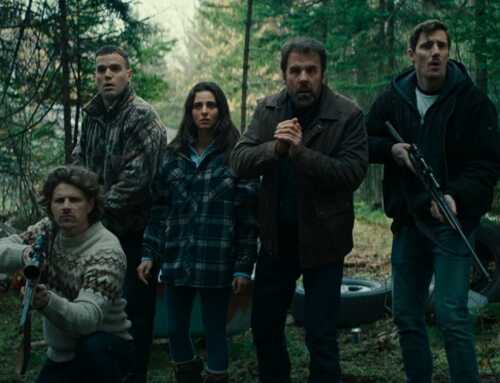Horror’s Un-Boo-Leivable Impact On Foreign Language Learning
Everyone remembers a time where a feary flick had them scared out of their wits. Even lovers of frightening films do, so don’t let them tell you otherwise.
Now, for me (and no laughing, please) it was that episode of Buffy with ‘The Gentlemen’. You know the one. Those levitating, ugly-yet-undeniably-dapper demons that, after taking away the voices of everyone in Sunnydale, stole the still-beating hearts from the chests of some unlucky college kids. Terrifying. Thursday night at 9 PM was the new-episode-of-Buffy night for me growing up and honestly, my pre-teen self-needed some real time off from our weekly family ritual after that.
Can we swiftly move on so I can go back to forgetting about this episode? Great.
These terrifyingly traumatic moments with scary cinema always hit home the hardest when we’re kids. Watching some slasher or splatter classic through gaps in our fingers that we’re far too young to see? Sure, that’ll do it. And what came of it? Nightmares for days after, and a lifetime of trepidation over having even one foot outside the comforter while sleeping.
Perhaps something people overlook when it comes to horror, however, is how useful it is to those that are learning a new language. Just like with most other genres of foreign entertainment, scary movies and TV shows can keep the lesson going when you’re not in language class. The key difference with this type of entertainment, though, is that while learning, you can sit back and enjoy something truly gory, gruesome, and downright awesome.
Binging and Bilingualism: A Match Made In Horror Heaven? (Or Hell)
Everyone knows that horror has its own universal language. Think about it: a blood-curdling scream from a scantily-clad Italian woman sounds the same as it would if they were Russian or English. When she inevitably winds up darting frantically through a dimly-lit forest at night to evade the killer – she could be screaming out in French, Spanish, or whatever else. You might not understand her words, but watch enough of this genre or put yourself in her shoes and it’s easy to get the gist of what our damsel in distress is shouting about.
As I’m sure we can all recognize, though – these tropes aren’t what make foreign horror great for growing your language skills. There’s a lot more to it than that. When you think about it, getting a real, on-the-ground understanding of the culture and localized lingo is what film offers, and this is something you can’t find behind the desk of a classroom. But that’s not all.
Just look at the back catalog that’s at your disposal. If you look at the last 50 years of Hollywood as an example, iconic characters like Michael Myers, Leatherface, Freddie Kruger, Jason Voorhees, and various others continue to create terror on our screens after decades.
You may not have realized, but countries across the world have been making their own mark on scary movies for a long time, too – it’s not just America that’s got the formula right. In fact, American productions often bomb. And it’s actually quite common to see highly original, international horror movies remade in the US, only to flop at the box office (we’re looking at you, The Grudge).
The list of places providing outstanding foreign frights is a long one. South Korea, Japan, and Thailand, as well as Austria, Australia, and various other countries continue to keep us on the edge of our seats. But they’re not the only ones.
What You Won’t Want To Miss If You’re Learning Any Of These Four Languages
Italy has the once-banned, unbelievably grim Cannibal Holocaust and Cannibal Ferox, as well as Dario Argento’s cult-classic and recently remade Suspiria. One of the top shows for those learning Italian right now is Janara. After a handful of children disappear in San Lupo, the locals are torn as to the cause: is it a kidnapper or are there otherworldly forces at play?
Thanks to the creative minds of Spain, we’ve had unmissable movies like The Day Of The Beast and the famous Rec tetralogy. Something all horror fans that are brushing up on their Spanish should check out is Inhibited. What starts out as a reunion among friends at a remote location soon turns into a stand-off – with paranoia, hunger, and anxiety to boot. It’s easily one of the best ways to learn Spanish for those that have a basic grasp already.
Hats off to Portugal. Anyone learning the language might be surprised to find out that it’s got a decent library of horror to work through. Titles like Act of Violence and the funny-yet-filthy Cannibal Club aren’t to be missed, and neither is Forest of Lost Souls. All you need to know is that two strangers meet by chance in Portugal’s suicide hotspot – you’ll have to find out what comes next for yourself.
From Amélie to La Haine, France has gifted the world some of the best filmmaking in history. And that includes horror. It was actually here that the first ever horror picture was made, back in 1896 – a short named Le Manoir du Diable. Fast forward and we have blockbuster hits like Inside as well as the so-stupid-it’s-great zombie movie, La Horde. For a production that’s a bit more, let’s say, modern… check out Velvet Children, and see what happens when a young man that’s been in isolation his whole life gets loose.
What’s mentioned above doesn’t even scratch the surface of what’s out there – even for those four countries alone. But if you’re looking to improve your knowledge with your chosen language – to really speak how the locals do – there’s plenty of entertainment for you to sink your teeth into. All it takes is a rudimentary Google search and you’ll find top-rated international titles right at your fingertips. And remember: each movie you watch doesn’t just help with dialect but cultural context, too! So get watching – and get screaming!







